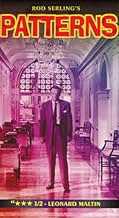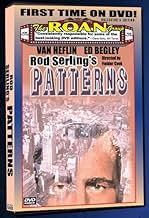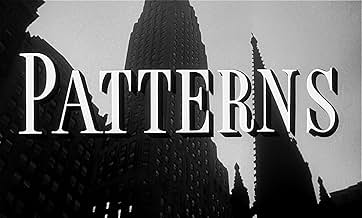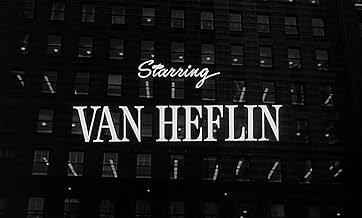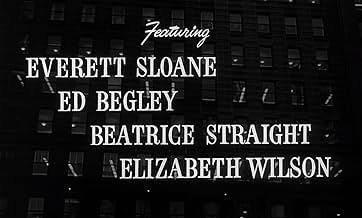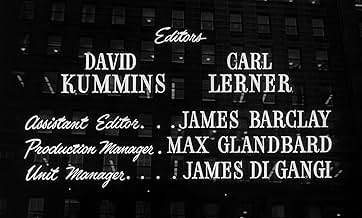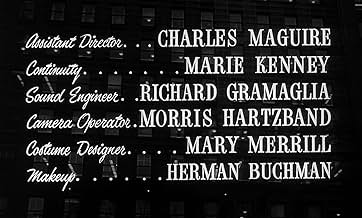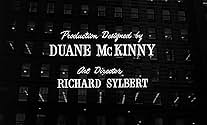When Fred Staples is recruited onto the board of a high-powered New York corporation, he finds his ethics and ambition at odds.When Fred Staples is recruited onto the board of a high-powered New York corporation, he finds his ethics and ambition at odds.When Fred Staples is recruited onto the board of a high-powered New York corporation, he finds his ethics and ambition at odds.
- Nominated for 1 BAFTA Award
- 1 nomination total
- D.J. Vandeventer
- (as Jack Livesy)
Storyline
Did you know
- TriviaYouthful industrial engineer Fred Staples (Van Heflin) is hired by ruthless CEO Walter Ramsey (Everett Sloane) to replace the aging Bill Briggs (Ed Begley). Heflin (48) was just seven years younger than Begley (55), and both were older than Sloane (47), the ages of the men listed when the film was released.
- GoofsThe dialog in the final scenes, starting with Staples' conversation with his wife in a coffee shop near his office, indicate the events take place well into the evening. However, the exterior shot linking this scene with Staples' confrontation with Ramsey in the Ramsey & Company building, as well as the exterior shot that follows the confrontation, were both taken in broad daylight.
- Quotes
Bill Briggs: On our level you don't get fired, you know that. After thirty years of productive work, they can't say to a man like me, "Alright, now get out!" They just can't do that. So what do they do? They create a situation. A situation you can't work in and finally that you can't live in with this tension, abuse. Small humiliations. It all starts out on a scale so subtle, so microscopic that at first you can't really believe it's happening at all. But gradually the thing begins to take shape. The pieces fit together - all the little bits. And it becomes unmistakable. They chip away at your pride, your security until you begin to have doubts, and then fears.
- ConnectionsReferenced in American Masters: Rod Serling: Submitted for Your Approval (1995)
Except for a brief use of subjective camera, director Cook films in a straightforward manner, letting the strong story carry events. I like the way he sets up the world of big business in the opening shots-- the cathedrals of capital towering over Wall Street pedestrians, the church bells signaling the sanctity of the mission, the subtle pecking-order among the secretaries based on who their boss is. It all smacks of industrious efficiency, revealed later on, however, as a very ruthless efficiency. The upwards shot of Heflin standing in the over-arched hallway tells us right away he's a man big enough to compete in this demanding environment.
Heflin is great as the small-town success suddenly promoted to the big city headquarters. Trouble is he's also brought a down-home sense of ethics, which handicaps his ability to survive the bloody board meetings presided over by CEO Everitt Sloane, aptly described as a human "barracuda". Unlike the other characters, Sloane's Walter Ramsey comes perilously close to a one-note caricature in his cold-hearted drive, salvaged only by a single-minded respect for competency and a desire to encourage full business potential. It's this latter that makes an otherwise implausible ending somewhat believable-- (I'd still like to know if the movie's compromised ending was Serling's original intent).
The cast is outstanding for their skill rather than for their looks, no small development in the glamor-obsessed 50's. Ed Begley's Bill Briggs makes for a tragic figure, an affecting left-over from the world of small business where an owner could address every employee by name. He and small town Heflin hit it off immediately, thereby heightening Heflin's predicament, the film's dramatic centerpiece. That post-war decade didn't provide many big roles for middle-age or plain-looking women. Both Wilson and Straight show how much the talent pool extended beyond the bosomy young things. Watch Wilson pause over the little potted plant that adorns her desk as she quits her job. Should she take it or not. Of course she takes it, because she's loyal not only to the needy Briggs, but to a tiny thing that would otherwise not survive the intense environment. It's a slight character touch like this that makes a movie stand out from the rest.
The key scene in the library is well handled. There, Heflin's wife (Straight) demonstrates her own wifely ambition, routed in typical 50's fashion through the success of her husband. When he hesitates, she insists on grabbing the brass ring, thereby forcing him to face his own suppressed ambition within the Darwinian world of corporate executives. As a result, I'm not sure I buy her sudden willingness at the end to "start over" away from the big house and fancy car. In fact, as good as the script is, there are a number of softening concessions to both people and plot.
Note Sloane's rationale for laying off employees in a distant plant-- By increasing efficiency through layoff, he asserts, new opportunities will eventually open up that will improve everyone's lot down the line. Some such version amounts to textbook theory and no doubt is sometimes true. But I wonder how true it is for millions of laid-off Americans whose good jobs have now been shipped overseas, and whose prospects now don't extend much beyond the local Mac Donald's. How true is it for them. No doubt, in Sloane's book, I'm indulging in rank sentiment and not the hard-headed principles that make capitalism continue to expand (but perhaps, not "grow"). That's the movie's crux and one that continues to press 50 years later. Patterns presents a somewhat hopeful 50's look at the big corporation; I'm not sure that a 21st century view would be quite so hopeful.
- dougdoepke
- Mar 22, 2008
- Permalink
- How long is Patterns?Powered by Alexa
Details
- Release date
- Country of origin
- Official sites
- Language
- Also known as
- Morgen trifft es dich
- Filming locations
- Pine Street and Nassau Street, Manhattan, New York City, New York, USA(Nancy drops off Fred on his first day at work)
- Production companies
- See more company credits at IMDbPro
- Runtime1 hour 23 minutes
- Color
- Sound mix
Contribute to this page



